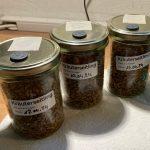Although legumes (e.g. beans, peas or lentils in all their varieties, forms and shapes) are available ready-to-use and cheap in any given supermarket, many people don’t know how to prepare them from their dried state. Yet, for an old freaky prepper like me 🙂 they are very useful: Their shelf life is a felt eternity, they’re nutritious and, well, occasionally they taste really good.
Legumes contain a fair and nutritionally reasonable amount of protein, vitamins and fibres, they can be prepared in a million ways and they’re well known all over the world in a gazillion of different dishes. They’re readily available for really cheap in packs of 250g up to sacks of 10kg and you can save money – and also waste – by using the dried variant instead of the canned ones. Not so bad, eh? So, here’s how to prepare them:
 (See this info image (german language) for cooking-, soaking-, and preparing times, taken from here. I have no images from the cooking process, but it’s SO easy, anyone will be able to reproduce this – promised. For our grandmothers, this was a perfectly normal way to prepare legumes.)
(See this info image (german language) for cooking-, soaking-, and preparing times, taken from here. I have no images from the cooking process, but it’s SO easy, anyone will be able to reproduce this – promised. For our grandmothers, this was a perfectly normal way to prepare legumes.)
1. Soak ’em
Not all dried legumes need to be soaked, the package will tell you what to do. But if they need to, soak them in plenty of water for about 12 hrs. or over night. Then drain them, discarding the soaking water and rinse them really thoroughly (this removes most of the starch and the contained hard-to-digest ingredients). All of this is not a mentionable piece of work, just think about it early enough (like, the evening before, etc.) and you won’t have any stress with it.
2. Cook ’em
Cook your (rehydrated) legumes over medium heat in plenty of water, covered (again, the package will tell you how long). Add a good pinch of salt about 15 min. before the end of the cooking process for more flavour. You can use a pressure cooker to minimze cooking time, but they cook completely on themselves, so you’re free to do anything else while they’re cooking. Nu fuzz at all.
3. Use ’em or Can ’em
From now on you can use them in whatever dish you fancy, just rinse again briefly and set aside. Or can them! In this case, fill them into sterilized glass jars, together with their cooking water and store them for later.


